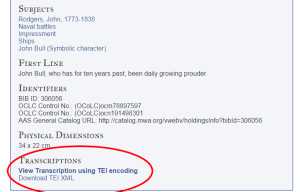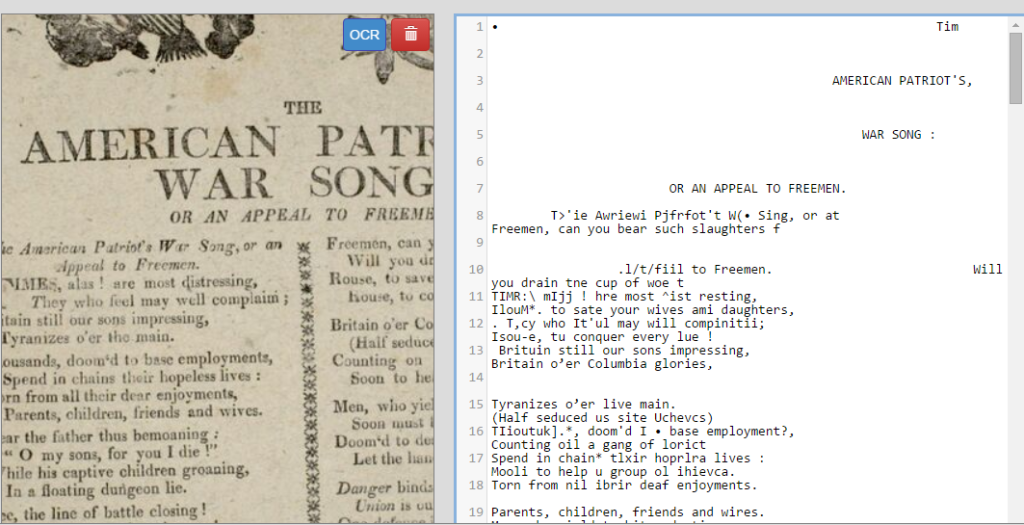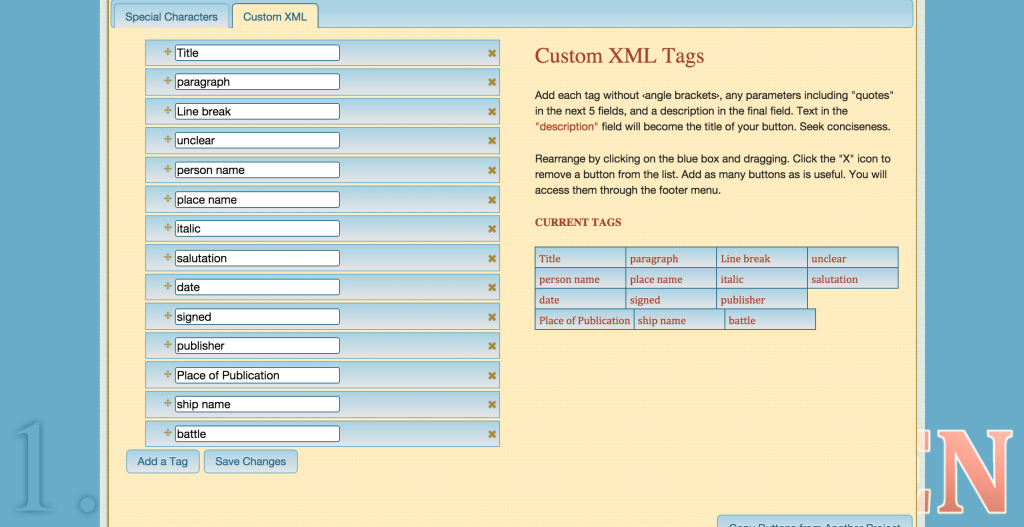Associate Professor of History at Assumption College Carl Robert Keyes and our digital humanities curator, Molly O’Hagan Hardy, recently collaborated to combine early American history and digital humanities in the classroom.
About a year ago, AAS launched the Isaiah Thomas Broadside Ballads Project: Verses in Vogue with the Vulgar. Featuring 338 broadsides, 800 images, and many contextualizing essays, the site, we hoped, gave scholars and ballad enthusiasts plenty to explore. We wanted more, however! One thing that the project lacked was transcriptions of the ballads themselves. The early type does not lend itself to optical character recognition (OCR) or the machine-reading of the texts. The example below from Juxta Editions OCR of The American Patriot’s War Song: or an Appeal to Freemen demonstrates how inadequate machine-reading is for these early texts.
This meant that we needed real people to do the transcribing. Having worked together at the Digital Antiquarian Workshop and discussed some of these very types of issues around digitization and the archives, Molly and Carl saw an opportunity to collaborate. Carl was getting ready to teach an upper-level History course at Assumption College, “From Colonies to Nation: Topics in the History of the American Revolution and the Early Republic,” and together, Molly and Carl thought through how the transcriptions of the ballads might be incorporated. The most direct benefit of a transcribed text is that it is then keyword searchable. Carl explained to his students in the assignment, “your work transcribing a ballad will make that historical document much, much more accessible to other scholars and the general public who visit the Isaiah Thomas Broadside Ballads Project online.”
Carl surveyed the collection of ballads in the collection and selected those that directly related to the War of 1812. In an effort to be as comprehensive as possible, he chose ballads from three categories: causes of the War of 1812, maritime battles on the Atlantic, and skirmishes in the North American interior (including campaigns against Canadian forces in the Great Lakes region). In addition to transcribing and tagging a ballad, each student researched and wrote an essay about the significance of the events depicted. In addition, they used Early American Newspapers to identify contemporary accounts of each incident. Eventually, these nineteenth-century newspaper accounts may be linked to the relevant ballads, further enhancing the site for visitors..
Molly had two goals for the transcription process: that the ballads could be easily transferred into XML files complete with TEI tags and that they could be doubly transcribed. TEI refers to the Textual Encoding Initiative, an international scholarly collaboration to produce encoding guidelines for the representation of texts in digital forms for optimal use in research, teaching, and preservation. AAS adopted TEI for the first time with its Just Teach One: Early African American Print project, and it is excited to continue its adherence to Guidelines for Scholarly Editions set out by the Modern Language Association. Molly decided to use an open, web-based tool called T-Pen that allows for transcribing and tagging of digital images. Though created for medieval manuscripts, T-Pen could work for the broadside ballads project as well (with a little tweaking, of course). Molly created the tags that the students would use as simple buttons:
When students highlighted a word during their transcribing process, they would then select the relevant button, and the following tags would be created around a person or place name, a change in the font, a title, a paragraph, or a word that is unclear.
The students were broken into teams, so each broadside had two students independently transcribing the same ballad. When they were finished, Molly collated the two transcriptions to decide on any differences. Molly then placed a TEI-header and validated each XML file, and they are now available in a fully searchable, TEI-encoded document. At t he bottom of the metadata associated with each ballad, a user will now be given the option to either view the transcription or to download the XML file with TEI encoding. The display is thanks to the interoperability of TEI Boilerplate with Omeka, the platform for the Isaiah Thomas Broadside Ballads Project. The TEI-tagging is fairly basic, and it is our hope that users will download what we have done and expand on it for their own purposes. The following broadsides now contain these additional features:
he bottom of the metadata associated with each ballad, a user will now be given the option to either view the transcription or to download the XML file with TEI encoding. The display is thanks to the interoperability of TEI Boilerplate with Omeka, the platform for the Isaiah Thomas Broadside Ballads Project. The TEI-tagging is fairly basic, and it is our hope that users will download what we have done and expand on it for their own purposes. The following broadsides now contain these additional features:
- Rodgers & victory. Tit for tat Or, The Chesapeake paid for in British blood
- Most brilliant aval [sic] victory on Lake Erie. Glorious news!!!
- Harrison victorious: : copy of a letter from General Harrison to the Department of War
- Capture of Little York: or Dearborn victorious in Canada
- A Bloody battle between the United States troops under the command of Gov. Harrison, and several tribes of Indians, near the Prophet’s town, Nov. 7th, 1811
- Another glorious victory. Newport, Oct. 18, 1813
- A new song, composed by James Campbell, a boatswain’s mate on board the Constitution
Molly visited Carl’s class both at the start of the semester and at the close of it. In her first visit, she explained the importance of this work in terms of the ballads’ accessibility. She also encouraged the students to consider the relationship between their work as historians and their work as transcribers and researchers in digital environments. In addition to the more formal analysis of the ballads that the students wrote, they also composed reflections on their experiences.
“By doing this kind of project,” one student wrote, “I feel like I am not doing something in the vacuum of college.…This outside connection gave it more meaning.” Several students indicated that sense of meaning derived from performing a service that “will help other scholars and students of History find the sources they need for their own work.” In addition, students recognized they further developed fundamental skills in the process of completing the project. For instance, one noted that XML tagging “helped me to get better at reading early American documents.”
The students verbalized many of these excellent insights in their final class meeting with Molly, and they also offered incredibly helpful feedback on the tagging system she had set-up. Not only have these Assumption students begun the transcription process, but they have also helped considerably to improve the project overall. Some might call such efforts “crowd sourcing,” but the spirit that emerged from this collaboration would much more aptly be described as “community sourcing.”
AAS hopes that this is the start of a number of public transcription projects, both of the ballads and of other collections, to come. As one student discovered, “I wrote it off as something only professional historians could do, but with a little training and practice, everyone is capable of transcribing.” Stay tuned!



One thought on “Transcribing the War of 1812: AAS Collections in the Classroom”